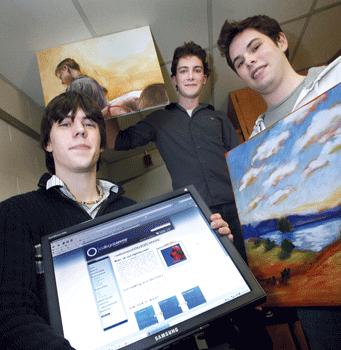Three juniors joined forces last year to solve a perennial decorating dilemma on college campuses: what to hang on those barren dormitory walls. They created a Web site, www.collegecanvas.com, which serves as an online gallery and virtual arts community. Prices for the drawings, photographs, prints, textiles, and paintings range from $10 to $450, enabling students to afford original artwork and the better-heeled to collect as-yet undiscovered artists.

The idea was born when John Harroff ’07 was visiting a high school friend enrolled at RISD and asked if he could borrow a painting to hang in his dorm room. “She saw it as a way to reduce the clutter in her cupboard,” he e-mailed from his home in Geneva, Switzerland, in August. Brown friends were impressed, he noted. “Some people even offered to buy it off me.”
An economics and international relations concentrator, Harroff had been idly talking with his suitemate and fellow economics student, Joe Lace ’07, about starting a business together. They decided to create a Web site that would bring together RISD and Brown students, matching supply with demand. They approached classmate Mike Frederickson for technological help.
A veteran entrepreneur and computer science concentrator, Frederickson had designed his first Web site in sixth grade to market a magnetic tie clip he’d invented. “People seemed much more interested in my Web site than in my stupid invention,” he joked in a phone interview from his summer job in California. In fact, USA Today featured the boy in an article on “Teens Who Mean Business,” which brought Frederickson some 1,300 e-mails soliciting his Web skills. The publicity kept him employed so effectively that Frederickson observed of his summer job doing computer animation for Pixar, “This is the first job I’ve had to report to.”
To raise funds for their start-up, Frederickson and Lace entered a campus “elevator-speech competition,” giving a pitch to a team of judges. “We bombed,” Lace said. “They told us it wouldn’t work. We were shocked.”
Undeterred, the students went it alone. Frederickson wrote all the code himself, keeping costs to a monthly $7 for rent on a shared server. When CollegeCanvas went live last fall, rent went up to $27 a month and the company splurged for the occasional ad on Facebook.com or The Daily Jolt. “We’re a lean business structure,” admits Lace.
CollegeCanvas missed last September’s decorating rush, but the site was up and ready this August. The company can ship to all fifty states, and accepts most major credit cards; the three founders handle all orders themselves. They say all of the artists on the site have sold artwork. None of the three will discuss their profits in detail, but Lace will divulge this much: “It’s not like we’re going out and buying cars—not even used cars,” he says. “It’s more like dinner Saturday nights.”
As the summer wound down, Lace finished up a grueling summer internship at a New York City investment bank, and Frederickson turned down a permanent job offer at Facebook.com, deciding to complete his senior year at Brown. Harroff had wrapped up a summer job at a financial software firm in New Jersey and was visiting family in Geneva before returning to Providence.
All three sounded eager to get back together and discuss ways to the CampusCanvas model to other college towns. One thing they knew: they didn’t want to lose the site’s intimate art-gallery feel. “We’re trying to build local communities,” Lace says. “One of the ideas for expanding would be a model more like Craigslist.” They could do worse.




